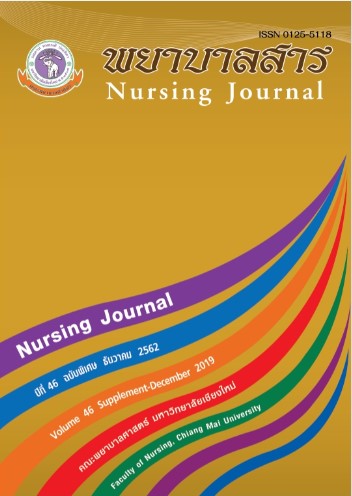Nursing Care of Children with Congenital Heart Disease
Keywords:
pediatric, congenital heart disease, principle nursing careAbstract
Congenital heart disease (CHD) is a persistent defect on 4-8 weeks of fetal life in structural anomalies of the heart present at birth. The incidence of CHD is approximately
0.8 -1% of all live births. CHD is divided in to two types: 1) Acyanotic heart disease and
2) Cyanotic heart disease. These persistence of defects of fetal structure after birth is actually or potentially of functional significance and is life-threatening such as congestive heart failure and anoxic spells. It is essential that pediatric nurses should clearly understand about CHD including pathophysiology and major cardiac complications. This would make them provide better nursing care and information to the children and families effectively to take care of their CHD children.
Principle of nursing care should focus on essential health information and instruct the caregivers to take care of their CHD children effectively. The most important nursing role to provide safety nursing care without critical condition and have a good quality of life.
References
Amornrat Ngamsuoy (2018).Parental behavior enhancement toward childhood home accidental injury prevention. Nursing Journal, 45 (4), 2018. (in Thai)
Ball, J. & Bindler, R. (1995). Alterations in cardiovascular function. In: Ball J, Bindler R, editors. Pediatric nursing: Caring for Children. Norwalk: Appleton & Lange.
Baumgartner, H., Bonhoeffer, P., De Groot, N.M. (2010). Guideline for the management of grown-up congenital heart disease. European Journal of Heart, 31, 2915-2957.
Bernier, P.L., Stefanescu, A., Samoukovic, G. (2010). The challenge of congenital heart disease worldwide:epidemiologic and demographic facts.Seminars in Thoracic and Cardiovascular Surgery Pediatric Cardiovascular Surgery Annual, 13, 26-34.
Dolidze, K., Smith, E., & Tchanturia, K. (2017). A model of children life intervention to facilitate effective coping in a child hospitalized for heart surgery. Clinical and Practice, 10 (5), 567-578.
Du, Q., Salem, Y., Liu, H., Zhou, X., Chen, S., & Chen, N., et al. (2017). A home-based exercise program for children with congenital heart disease following interventional cardiac catheterization: study protocol for randomized control trial. Biological and Medical Control, 18 (38), 1-9.
Hoffman, J.I. (2013). The global burden of congenital heart disease. Cardiovascular Journal of Africa, 24, 141-145.
Kuriata, E. & Sawicki, W. (2015). Evaluation of cases with the usage of commercially available tablets in the pediatric formula. Acta Poloniae Pharmaceutica and Drug Research, 72 (3), 551-558.
London, M.L., Ladewig, P.W., Ball, J.W., Blinder, R.C. (2003). The child with alterations in cardiovascular function. In: London ML, Ladewig PW, Ball JW, Blinder RC, editors. Maternal Newborn & Child Nursing. Newjersy: Pearson education, Inc.
Nishimura, R.A., Otto, C.M. Bonow, R.O. (2017). AHA/ACC focused update of the 2014 AHA/ACC guideline for the management of patients with a valvular heart disease:
a report of the American College of Cardiology/American Heart Association Task Force on Clinical Practice Guideline. The Journal American College of Cardiology, 70 (2), 252- 289.
Nuttanicha Sriboonyawattana & Sujitra Tiansawad (2017.Validation of child health status questionnaire for Thai school-age children. Nursing Journal, 44 (2), 2017. (in Thai)
Pabari, R.M., Mcdermott, C., Barlow, J., & Ramtoola, Z. (2012). Stability of an alternative extemporaneous captopril fast-dispersing tablet formulation versus an extemporaneous oral lipid formulation. Clinical Therapeutics, 34(11), 2221-2229.
Park, M.K. (2008). Pediatric Cardiology for Practitioner (5th ed.). London: Springer Publishing.
Ratanasit, N., Karaketklang, K., Jakrapanichakul , D., Kittipovanonth, M., Punlee, K, Rochanasiri, W., Phrudprisan, S. (2015). Prevalence and Echocardiographic Characteristics of Common Congenital Heart Disease in Adult Patients at Siriraj Hospital: 10-Year Study. Journal of the Medicine Association of Thailand, 98 (1), 1-13.
Sarris, G.E., Balmer, C., Bonou, P. (2017). Clinical guidelines for the management of patients with transposition of the great arteries with intact ventricular septum: the task force on transposition of the great arteries of the European association for cardio-thoracic surgery. Cardiology in Young, 27 (3), 530-569.
Stout, K.K., Daniels, C.J., Aboulhosn, J.A. (2018). AHA/ACC guideline for the management of adults and pediatric with congenital heart disease: a report of the American college of cardiology/American heart association task force on clinical practice guidelines. Circulation, 139, 695-800.
Suklerttrakul, T., Picheansathian, W., Jintrawet., U., & Chotibang, J. (2018). Support Program for Thai Mothers of Toddlers with Congenital Heart Disease: A Randomized Control Trial. Pacific Rim International Journal of Nursing Research, 22(2), 106-119.
Thitima Suklerttrakul (2018). Nursing care for children with electrolyte imbalances. Nursing Journal, 45 (4), 2018. (in Thai)
Downloads
Published
How to Cite
Issue
Section
License
บทความที่ได้รับการตีพิมพ์เป็นลิขสิทธิ์ของวารสารพยาบาลสาร
ข้อความที่ปรากฏในบทความแต่ละเรื่องในวารสารวิชาการเล่มนี้เป็นความคิดเห็นส่วนตัวของผู้เขียนแต่ละท่านไม่เกี่ยวข้องกับมหาวิทยาลัยเชียงใหม่ และคณาจารย์ท่านอื่นๆในมหาวิทยาลัยฯ แต่อย่างใด ความรับผิดชอบองค์ประกอบทั้งหมดของบทความแต่ละเรื่องเป็นของผู้เขียนแต่ละท่าน หากมีความผิดพลาดใด ๆ ผู้เขียนแต่ละท่านจะรับผิดชอบบทความของตนเองแต่ผู้เดียว






